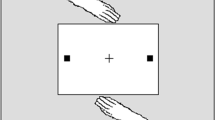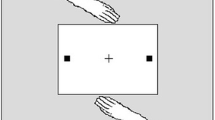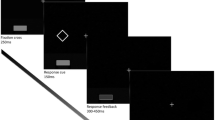Abstract
Social inhibition of return is the phenomenon whereby an individual is slower to reach to locations to which another individual has recently responded. Although this suggests that an observer represents another person’s action, little is known about which aspects of the action are encoded. The present work describes a series of three experiments examining whether social inhibition of return represents the endpoint goal of the action, i.e., is ‘goal based’. Pairs of participants sat opposite to one another and alternated responses to a cued or non-cued object presented on a table top. Importantly, either the two participants performed the same interaction with the object or a different interaction. Although all our experiments showed social inhibition of return, the size of the effect was not modulated according to whether each participant had the same or different goal. We conclude that although the mechanisms giving rise to social inhibition of return do encode some aspects of a response they do not code for terminal action goals.





Similar content being viewed by others
References
Abrams, R. A., & Christ, S. E. (2003). Motion onset captures attention. Psychological Science, 14, 427–432.
Bekkering, H., Wohlschläger, A., & Gattis, G. (2000). Imitation of gestures in children is goal-directed. Quarterly Journal of Experimental Psychology: Human Experimental Psychology, 53(A), 153–164.
Berger, A., & Henik, A. (2000). The endogenous modulation of IOR is nasal-temporal asymmetric. Journal of Cognitive Neuroscience, 12, 421–428.
Brennan, S. E., Chen, X., Dickinson, C. A., Neider, M. B., & Zelinsky, G. J. (2008). Coordinating cognition: The costs and benefits of shared gaze during collaborative search. Cognition, 106, 1465–1477.
Carpenter, M., Akhtar, N., & Tomasello, M. (1998). Fourteen- through 18-month-old infants differentially imitate intentional and accidental actions. Infant Behavior and Development, 21, 315–330.
Cattaneo, L., Fabbri-Destro, M., Boria, S., Pieraccini, C., Monti, A., Cossu, G., et al. (2007). Impairment of actions chains in autism and its possible role in intention understanding. Proceedings of the Nation Academy of Sciences, 104, 17825–17830.
Cave, K. R., Bush, W. S., & Taylor, T. G. G. (2010). Split attention as part of a flexible attentional system for complex scenes: Comment on Jans, Peters, and De Weerd (2010). Psychological Review, 117, 685–696.
Cole, G. G., Gellatly, A. R. H., & Blurton, A. (2001). Effect of object onset on the distribution of visual attention. Journal of Experimental Psychology: Human Perception and Performance, 27, 1356–1368.
Cole, G. G., & Kuhn, G. (2009). Appearance matters: Attentional orienting by new objects in the precuing paradigm. Visual Cognition, 17, 755–776.
Cole, G. G., & Kuhn, G. (2010). What the experimenter’s prime tells the observer’s brain. Attention, Perception, & Psychophysics, 72, 1367–1376.
Cole, G. G., Kuhn, G., & Liversedge, S. P. (2007). Onset of illusory figures attenuates change blindness. Psychonomic Bulletin & Review, 14, 939–942.
Cole, G. G., & Liversedge, S. L. (2006). Change blindness and the primacy of object appearance. Psychonomic Bulletin & Review, 13, 588–593.
Croson, R., & Sundali, J. (2005). The Gambler’s fallacy and the hot hand: Empirical data from casinos. Journal of Risk and Uncertainty, 30, 195–209.
Daprati, E., & Sirigu, A. (2006). How we interact with objects: Learning from brain lesions. Trends in Cognitive Sciences, 10, 265–270.
di Pellegrino, G., Fadiga, L., Gallese, V., & Rizzolatti, G. (1992). Understanding motor events: A neurophysiological study. Experimental Brain Research, 91, 176–180.
Eimer, M., & Schlaghecken, F. (1998). Effects of masked stimuli on motor activation: Behavioral and electrophysiological evidence. Journal of Experimental Psychology: Human Perception and Performance, 24, 1737–1747.
Fogassi, L., Ferrari, P., Gesierich, B., Rozzi, S., Chaersi, F., & Rizzolatti, G. (2005). Parietal lobe: From action organization to intention understanding. Science, 308, 662–667.
Gallese, V., Fadiga, L., Fogassi, L., & Rizzolatti, G. (1996). Action recognition in the premotor cortex. Brain, 119, 593–609.
Gattis, M., Bekkering, H., & Wohlschläger, A. (2002). Goal-directed imitation. In A. N. Meltzoff & W. Prinz (Eds.), The Imitative Mind (pp. 183–205). Cambridge, England: Cambridge University Press.
Hayes, S. J., Hansen, S., & Elliot, D. (2009). Between-person effects on attention and action: Joe and Fred revisited. Psychological Research, 74, 302–312.
Hommel, B. (2009). Action control according to TEC (theory of event coding). Psychological Research, 73, 512–526.
Jeannerod, M. (1999). The 25th Bartlett Lecture: To act or not to act: Perspectives on the representation of actions. The Quarterly Journal of Experimental Psychology, 52, 1–29.
Khatoon, S., Briand, K. A., & Sereno, A. B. (2002). The role of response in spatial attention: Direct versus indirect stimulus–response mappings. Vision Research, 42, 2693–2708.
Kingstone, A., & Pratt, J. (1999). Inhibition of return is composed of attentional and oculomotor processes. Perception & Psychophysics, 61, 1046–1054.
Klein, R. M., & MacInnes, W. J. (1999). Inhibition of return is a foraging facilitator in visual search. Psychological Science, 10, 346–352.
Kuhn, G., Tatler, B. W., & Cole, G. G. (2009). You look where I look! Effect of gaze cues on overt and covert attention in misdirection. Visual Cognition, 17, 925–944.
Lupiàñez, J., & Milliken, B. (1999). Inhibition of return and the attentional set for integrating vs. differentiating information. Journal of General Psychology, Theme Issue on Visual Attention, Part 2, 126, 392–418.
Lupiàñez, J., Milliken, B., Solano, C., Weaver, B., & Tipper, S. P. (2001). On the strategic modulation of the time course of facilitation and inhibition of return. Quarterly Journal of Experimental Psychology, 54A, 753–773.
Mayer, A. R., Seidenberg, M., Dorflinger, J. M., & Rao, S. M. (2004). An event-related fMRI study of exogenous orienting: Supporting evidence for the cortical basis of inhibition of return? Journal of Cognitive Neuroscience, 16, 1262–1271.
Mukamel, R., Ekstrom, A. D., Kaplan, J., Iacoboni, M., & Fried, I. (2010). Single-neuron responses in humans during execution and observation of actions. Current Biology, 20, 750–756.
Posner, M. I., & Cohen, Y. (1984). Components of visual orienting. In H. Bouma & D. G. Bouwhuis (Eds.), Attention and Performance X (pp. 531–556). Hillsdale, NJ: Erlbaum.
Posner, M. I., Rafal, R. D., Choate, L. S., & Vaughan, J. (1985). Inhibition of return: Neural basis and function. Cognitive Neuropsychology, 2, 211–228.
Prinz, W. (1997). Perception and action planning. European Journal of Cognitive Psychology, 9, 129–154.
Rieger, M., & Gauggel, S. (1999). Inhibitory after-effects in the stop-signal paradigm. British Journal of Psychology, 90, 509–518.
Riess-Jones, M., Moynihan, H., MacKenzie, N., & Puente, J. (2002). Temporal aspects of stimulus-driven attending in dynamic arrays. Psychological Science, 13, 313–319.
Rizzolatti, G., Fabbri-Destro, M., & Cattaneo, L. (2008). Mirror neurons and their clinical relevance. Nature Clinical Practice Neurology, 5, 24–34.
Rubichi, S., Nicoletti, R., Iani, C., & Umilta, C. (1997). The simon effect occurs relative to the direction of an attentional shift. Journal of Experimental Psychology: Human Perception and Performance, 23, 1353–1364.
Schuch, S., & Tipper, S. P. (2007). On observing another person’s actions: Influences of observed inhibition and errors. Perception & Psychophysics, 69, 828–837.
Sebanz, N., Knoblich, G., & Prinz, W. (2003). Representing others’ actions: Just like one’s own? Cognition, 88, 11–21.
Simon, J. R. (1969). Reactions toward the source of stimulation. Journal of Experimental Psychology, 81, 174–176.
Sirigu, A., Cohen, L., Duhamel, J. R., Pillon, B., Dubois, B., & Agid, Y. (1995). A selective impairment of hand posture for object utilisation in apraxia. Cortex, 31, 41–55.
Skarratt, P. A., Cole, G. G., & Kingstone, A. (2010). Social inhibition of return. Acta Psychologica, 134, 48–54.
Suzuki, S., & Cavanagh, P. (1997). Focused attention distorts visual space: A attentional repulsion effect. Journal of Experimental Psychology: Human Perception and Performance, 23, 443–463.
Taylor, T. L., & Klein, R. M. (2000). Visual and motor effects in inhibition of return. Journal of Experimental Psychology: Human Perception and Performance, 26, 1639–1656.
Tipper, C., & Kingstone, A. (2005). Is inhibition of return a reflexive effect? Cognition, 97, B55–B62.
Welsh, T. N., Elliot, D., Anson, J. G., Dhillon, V., Weeks, D. J., Lyons, J. L., et al. (2005). Does Joe influence Fred’s actions? Inhibition of return across different nervous systems. Neuroscience Letters, 385, 99–104.
Welsh, T. N., Lyons, J., Weeks, D. J., Anson, J. G., Chua, R., Mendoza, J., & Elliot, D. (2007). Within- and between-person inhibition of return: Observation is as good as performance. Psychonomic Bulletin & Review, 14, 960–956.
Welsh, T. N., McDougall, L. M., & Weeks, D. J. (2009a). The performance and observation of action shape future behaviour. Brain and Cognition, 71, 64–71.
Welsh, T. N., Ray, M. C., Weeks, D. J., Deweyd, D., & Elliott, D. (2009b). Does Joe influence Fred’s action? Not if Fred has autism spectrum disorder. Brain Research, 1248, 141–148.
Acknowledgments
This work was supported by UK Economic and Social Research Council Grant RES-000-22-1766 and a research development grant from the University of Essex. The authors thank the reviewers for their assistance on earlier drafts of this article.
Author information
Authors and Affiliations
Corresponding author
Rights and permissions
About this article
Cite this article
Cole, G.G., Skarratt, P.A. & Billing, RC. Do action goals mediate social inhibition of return?. Psychological Research 76, 736–746 (2012). https://doi.org/10.1007/s00426-011-0395-7
Received:
Accepted:
Published:
Issue Date:
DOI: https://doi.org/10.1007/s00426-011-0395-7




